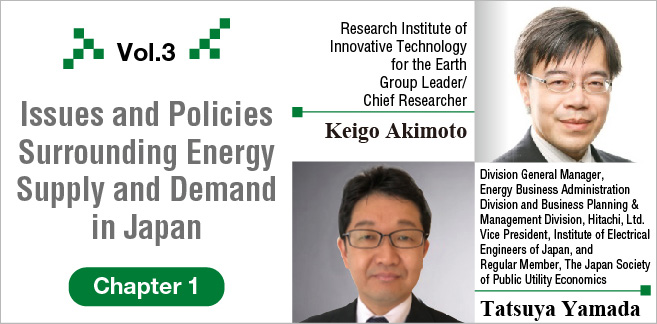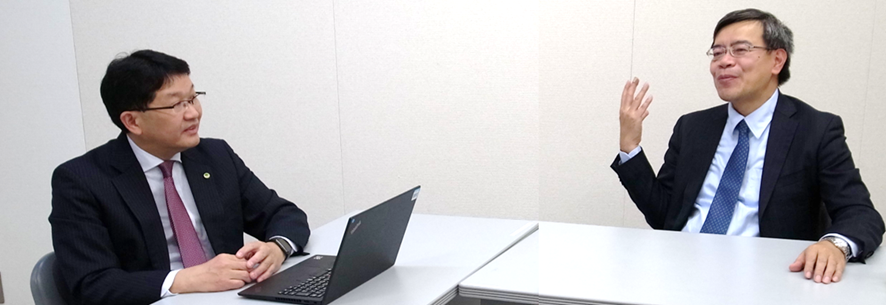
In this third part of our “Listening to Key Persons” series, we spoke with Keigo Akimoto, Chief Researcher and Group Leader of the Systems Analysis Group at the Research Institute of Innovative Technology for the Earth (RITE), who specializes in the analysis and evaluation of energy and environmental systems and policy recommendations for strategies to combat global warming. Mr. Akimoto is an active member of government expert panels and committees on climate change and energy issues, and is engaged in a wide range of research and policy recommendation activities in energy and environment-related fields. Mr. Yamada asked Mr. Akimoto what kind of policies the Japanese government is pursuing to achieve carbon neutrality, and what kind of energy innovation is required.

In the first part (Chapter 1), the discussion focuses on current energy supply and demand issues in Japan that are the backdrop to promoting energy innovation, and policies being pursued by the Japanese government.
Yamada:The weather forecast says that snow will fall later today, and there have been many days with relatively low temperatures this winter, so there are concerns about a tight electricity supply-demand balance following on from last year. Soaring electricity prices are also putting pressure on our daily lives and finances. How do you see this situation?
Akimoto:I think that there are multiple factors at play, and they are intricately intertwined. One of those factors is the liberalization of the electric power industry, which Japan has been pursuing for over 20 years. Of course, liberalization has brought major benefits in terms of encouraging market participation and competition among the various industry players. On the other hand, with the introduction of market mechanisms for electricity supply and demand accompanying liberalization, there are less funds available for capital investment in equipment and facilities, which is necessary from a long-term perspective. In other words, the market works on short-term gains and losses, so electric power shortages do not immediately lead to an increase in supply. Especially in the case of large power sources such as nuclear power plants, it takes many years to see a return on the initial investment. Normally, a long-term perspective is essential to achieve an optimal state of electricity supply and demand. One of the root causes of the tight supply-demand balance we are seeing now is that this long-term perspective has not functioned well within the current market mechanism.
Yamada:So, the integration of the electricity supply into the market, which was initiated by liberalization, has made it impossible to make optimal investments from a long-term perspective. In addition to these systemic problems, Japan's economic growth has also slowed to a halt, and we can say that is another one of the reasons why investment is not increasing.
Akimoto:The introduction of the Feed-in Tariff (FIT) system for renewable energy—which is aimed at achieving decarbonization—has also further complicated the situation. Increasing renewable energy is crucial in order to achieve carbon neutrality. But as a result of rules to prioritize the use of renewable energy, which has zero marginal costs, existing power sources such as thermal power generation are being forced to withdraw. If the utilization rate of facilities declines, then investment will naturally become economically infeasible. Additionally, since the supply of renewable energy is unstable, if the amount of thermal power generation—which is more agile in responding to changes in demand—decreases, then it will not be possible to respond when a situation that exceeds expectations occurs. In other words, we can say that the tight electricity supply-demand balance that we are currently experiencing is, in a sense, an inevitable problem that has arisen in the course of the greater trends of the times.

Akimoto:Another issue is that it has recently become difficult to secure supplies of liquefied natural gas (LNG). In particular, the cold winter of 2021 led to an increase in demand for LNG, and countries around the world bought up all the LNG they could get their hands on, resulting in a shortage of supply. The investment issue we touched on earlier is about the inability to secure kilowatts (kW)—that is, future power supply (power generation) capacity. But now we are talking about a shortage of kilowatt-hours (kWh)—that is, the amount of electricity needed now. Moreover, due to the situation in Ukraine, there is a constant, ongoing shortage of LNG. In order to secure it, LNG will continue to be purchased at high prices. I think that we will continue to bear the risks of tight LNG supply, the resulting shortage of kWh, and rocketing electricity prices for some time to come.
Yamada:Power consumption peaks in winter, especially from the evening onward. But if the ratio of variable-output power sources—especially solar power generation, which decreases after evening—in the energy mix increases, then an imbalance between supply and demand will inevitably occur. I feel that it will be a very great challenge to manage the electricity supply-demand balance from evening onward in the winter months, when power consumption peaks. Currently, we have no choice but to rely on power sources such as LNG thermal power generation.
Akimoto:Yes, it's just as you say. As for LNG, major economic powers such as Germany and China have bought up supplies, causing a situation where developing countries have been unable to buy it. From a standpoint of fairness and equity, we must consider how to ensure a stable supply of energy for the world as a whole, and consider Japan's role and responsibilities in the international community.
Yamada:Mr. Akimoto, as a member of the Basic Policy Subcommittee of the Advisory Committee for Natural Resources and Energy, you engage in discussions on Japanese national energy policy. What kind of discussions are being held with regard to ensuring a stable supply of energy?
Akimoto:Against the backdrop of the issues, I mentioned at the beginning, measures to address structural shortages in power supply capacity are being discussed. As one of these measures, the capacity market*1 framework was introduced in 2020. However, what is traded under this framework is "capacity to supply power in four-years' time," and actual supply will begin from fiscal 2024 onward. The urgent issue is how to endure the current situation until then.
Additionally, even if supply does starts in four years, it may collapse the following year as long as it relies on market mechanisms. In fact, prices have fluctuated greatly since the auction started, making it an unsuitable system for power sources that assume long-term operation, such as nuclear power. Large-scale power supplies cannot be built in four years, anyway, and this system does not provide sufficient follow-up.
The "Long-term Decarbonized Power Supply Auction" system has been considered as a response to this, and public applications will begin in fiscal 2023. In principle, the country (or other buyer) promises to purchase power for 20 years and gives a grace period until the start of operation, with the aim of encouraging investment in long-term power sources. As I strongly expressed in the subcommittee, this market includes a wide variety of power sources such as thermal power generation, hydrogen power generation, ammonia power generation, and CCS/CCUS*2, as well as nuclear power. In this way, through competition, the system aims to increase the number of cost-effective power sources that contribute to decarbonization.
However, since a transition is also necessary and it is difficult to proceed with decarbonization all at once, bidding is allowed during the transition stage on the condition that the supplier shows a path to the future for transient power generation, such as dual firing with both hydrogen and ammonia or an LNG combined cycle.
Yamada:I have high hopes for this new system, but I get the impression that it is somewhat lacking from the perspective of encouraging necessary investment in nuclear power generation. Even with the government's series of moves toward nuclear power generation, such as restarting nuclear existing power plants, constructing new plants and replacing old ones, and extending plant operating periods—will nuclear power generation be able to survive in a competitive market in the future? If (the government) believes that nuclear power is an indispensable source of power for achieving carbon neutrality, I would like to hope for further support on the policy front.
Akimoto:As you say, these systems alone are not sufficient, and the situation is still unpredictable. However, I do believe that these efforts will lead to greater predictability of investment returns. Personally, I expect that if this mechanism works well, then we will be able to encourage the continuous "metabolism" of power sources, which will contribute not only to the stable supply of energy but also to decarbonization.

Yamada:Turning back to the world stage again, please tell us your impressions of attending the 27th Conference of the Parties to the UN Framework Convention on Climate Change (COP27).
Akimoto:The theme of the metaphorical "homework" taken away from COP26 was to dig deeper into emission reduction targets, but unfortunately this time we saw almost no progress with regard to this. Japan has also set a fairly challenging reduction target of -46% (compared to 2013) by 2030, and partly due to the situation in Ukraine there was no leeway for major powers such as China or developing countries to dig deeper into their targets.
At the same time, a major point of contention was the discussion on "loss and damage." This is a framework in which developing countries seek compensation from developed countries that have emitted large amounts of greenhouse gases, for losses and damages incurred as a result of disasters caused by climate change. However, while emissions from developed countries are decreasing, emissions from China, India, and Russia are also increasing, and discussions on this issue have run into difficulties. In the end, the greatest outcome of COP27 was the agreement to create a fund, as a compromise.
However, although an agreement has been reached, it is doubtful that it will be enforceable. For example, I don't think that the US government will contribute to the fund given the current state of Congress. Since the Paris Agreement, although each country has put forward different arguments, the world had been moving toward a single trend of working to solve the problem of climate change. But now the world is once again moving toward a state of division, as seen in the situation in Ukraine and the US-China confrontation. Practical problem solving is becoming increasingly difficult.
Therefore, now that it is difficult to realize carbon neutrality through international cooperation, I think it is crucial for us to develop cheaper energy supply technologies and move toward decarbonization while at the same time pursuing economic feasibility.
Yamada:That is a very convincing opinion. At present, the realization of carbon neutrality is still often regarded as a cost to reduce greenhouse gases. Certainly, from a short-term perspective, it is a cost, and there will inevitably be some reluctance. From the perspective of 2030 and 2050, though, achieving carbon neutrality is actually an opportunity to create new technologies and businesses, and can be said to be a form of growth strategy. If we regard achieving carbon neutrality as a growth strategy, then the pursuit of economic feasibility is essential. I believe that digital technologies will contribute greatly to this.
Akimoto:The use of digital technologies is very important. Looking ahead, in particular, I believe that managing the supply and demand of energy by successfully linking digital transformation (DX) with green transformation (GX), and making effective use of power-related data and linking it to new value will become very important key themes for Japan's (economic) growth.
Keigo Akimoto
Keigo Akimoto is Group Leader of Systems Analysis Group and Chief Researcher, Research Institute of Innovative Technology for the Earth (RITE), and Specially Appointed Professor, Institute of Innovative Research, Tokyo, Institute of Technology.
He received Ph.D. degree from Yokohama National University in 1999. He was a guest professor, Graduate School of Arts and Sciences, the University of Tokyo between 2010 and 2014, and a Lead Author for the Fifth and Sixth Assessment Report of Intergovernmental Panel on Climate Change (IPCC). He is a member for several advisory bodies on energy and climate change policies for the Government of Japan including Strategic policy committee in Natural Resources and Energy. His scientific interests are in modeling and analysis of energy and environment systems.
Tatsuya Yamada
Division General Manager, Energy Business Administration Division and Business Planning & Strategy Division, Hitachi, Ltd.
Vice President, Institute of Electrical Engineers of Japan, and Regular Member, The Japan Society of Public Utility Economics.
Tatsuya Yamada joined Hokuriku Electric Power Company in 1987, and was seconded to The Institute of Energy Economics, Japan in 1998 before joining Hitachi, Ltd in 2002.
He has engaged in tasks involved in the planning of strategies for energy-related businesses, and became Director of the Management Planning Office, the Strategy Planning Division in 2014, Senior Manager of the Business Planning Division, the Energy Solution Business Unit in 2016, General Manager of the Business Planning Division, the New Age Energy Business Co-create Division in 2019, and assumed his present positions in 2020.